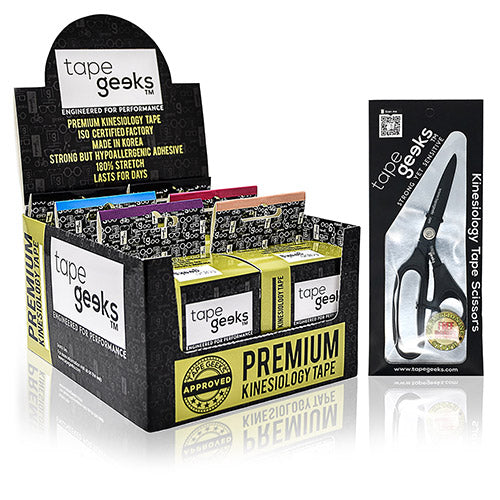
Tricep strain is an injury to the triceps muscle. The triceps is a three-headed muscle in the back of the upper arm. A tricep strain occurs when one or more of the muscles is stretched or torn.
Do you think you’ve strained your triceps?
In this article, learn about the common causes of tricep strain, symptoms, and available treatments. We’ll also be talking about a kinesiology taping protocol that you can do to help give support while alleviating some of the discomforts that you may feel from the strain.

Shop our kinesiology tape now
Shop NowWhat are the causes of tricep strain?
One of the most common causes of tricep strain is overuse. This can occur from doing too much repetitive activity that stresses the triceps muscle, such as weightlifting or other forms of exercise.
- A sudden increase in the intensity of your physical activities
- Not warming up enough before exercise or playing sports
- Improper technique when performing a repetitive exercise movement
Other causes include trauma to the triceps muscle, such as from a fall or direct blow, and medical conditions that affect the muscle like diabetes or thyroid problems.
What are the common tricep strain symptoms?

Here are some of the most common symptoms that you may experience when you have tricep strain:
- Pain when extending the arm
- A popping sound at the time of injury
- Swelling
- Bruising
- Tender to the touch
How is tricep strain diagnosed?
Your healthcare provider may do the following test to determine if you have a tricep strain and to know the best treatment plan for you:
- Ultrasound
- Magnetic Resonance Imaging (MRI)
- X-ray
What are the available treatments for tricep strain?
Here are some of the conservative treatment options that you can do for tricep strain:
- RICE Protocol. In initially treating tricep strain, you should remember the RICE protocol which means:
- Rest. Rest from activities and avoid doing activities that can further irritate the area.
- Ice. Applying ice or ice packs will help in reducing pain and swelling. You should only put ice for about 20 minutes at a time to avoid damaging your skin.
- Compression. Compressing the area using bandages or wraps helps give support to the area.
- Elevation. Elevating the triceps above the level of your heart helps reduce swelling.
- Kinesiology tape. Applying kinesiology tape to the area promotes blood flow and circulation. The tape also provides support without limiting your range of motion. Additionally, it will also help relieve pressure while aiding in reducing inflammation.
- Over-the-counter (OTC) anti-inflammatory medication. Taking anti-inflammatory medications like ibuprofen naproxen, and aspirin can help with pain and swelling.

Shop our bundles now
Shop Now
How do you apply kinesiology tape for a tricep strain?
If you’re new to kinesiology tapes, their benefits are worth knowing, especially if you’re prone to aches and pains. The crucial thing to note is that kinesiology tape helps lift the skin away from the underlying tissues. This will help increase circulation in the area and help alleviate the discomfort you feel.
Before your tricep application, here are some tips on how to prepare beforehand. And, since you’ll be applying different kinesiology tape tensions, learn more about it here.
*You may need a partner for this kinesiology taping application since it is a hard-to-reach area.
- Measure out your tape. It should span from the back of your shoulder down past the elbow. Cut your tape to form a long I-strip.
- Anchor the tape with 0% tension on the back of the shoulder. Next, have your elbow bent and give the rest of the tape fifteen to twenty-five percent tension before applying. Ensure that you give the tape ends 0% tension.
- Rub the tape to activate the adhesive.
Tape Geeks: Get great support for your tricep without skin damage!

Shop our collection now
Shop NowGet the best kinesiology tape support for your triceps without damaging your skin with Tape Geeks! Made from high-quality adhesives, avoid rashes and allergies.
Enjoy a great stick without making your skin sick with Tape Geeks kinesiology tape! TG tapes are hypoallergenic, zinc-free, and latex-free. What’s more, they’re manufactured in an ISO-certified and dermatologist-approved factory in South Korea which is known for their consistent and reliable adhesives.
Get the best deals for Tape Geeks' products by visiting our Amazon store today!
How do you prevent tricep strain?
Here are some of the things to remember to avoid a tricep strain:
- Stretch and warm up before exercising or playing sports
- Use proper technique, especially performing repetitive movements during exercise
- Do not overexercise as it may lead to torn muscles and tendons.
Conclusion
In this post, we’ve talked about the common causes of tricep strain and some of the treatments that are available. We also discussed a kinesiology taping protocol that you can use to help give support while alleviating some of the discomforts that you may feel from the strain.
If you experience any discomfort or pain in your triceps muscles, be sure to consult with a medical professional for diagnosis and treatment.
You can find more information about different aches and pains like biceps tendonitis as well as quad strain in our blog.
Thanks for reading!

Shop our accessories and more
Shop Now
Subscribe to the TapeGeeks Newsletter for new videos, discounts and more!Join The Geeks Club









